Social Media SWOT Analysis: How To Make Your Insights Work for You
Learn how to conduct a social media SWOT analysis to identify strengths, weaknesses, opportunities, and threats across platforms.


Want to know exactly where your online presence stands? A social media SWOT analysis gives you a clear plan so you can make smart choices instead of guessing.
This guide will show you how to find your social media wins, losses, new chances, and potential problems. Buckle up for steps and tools you can use right away. Whether you’re running social media marketing for a small brand or a big company, this will help you and your team focus on what matters.
Key takeaways:
-
A social media SWOT analysis examines platform-specific strengths (like high video engagement) and weaknesses (like poor posting consistency) to guide strategic decisions rather than following hunches and generic trends.
-
A comprehensive SWOT framework analyzes engagement metrics and content performance (strengths), identifies strategy gaps (weaknesses), discovers relevant trends and partnership possibilities (opportunities), and monitors algorithm changes and competitive threats (threats).
-
Perform a SWOT analysis when launching campaigns, exploring new channels, auditing performance, or benchmarking competitors.
What is a social media SWOT analysis?
A social media SWOT analysis is a structured method to assess your current social media marketing efficiency by examining four key areas: strengths, weaknesses, opportunities, and threats. It’s a great way to make informed decisions about your social media strategy by understanding where you stand and what factors might affect your success.
Unlike general marketing assessments, a SWOT analysis focuses specifically on your digital presence across platforms like Facebook, Instagram, TikTok, and others.
Let’s break down what each component means for your social media work:
Strengths
- What’s working? These are the internal factors where your social media marketing excels. When identifying strengths, look at:
- Content performance: Which types of posts receive the most reactions?
- Social media engagement: Are followers actively commenting, sharing, and interacting with your content?
- Brand loyalty: Do you have a core group of followers who consistently engage with and advocate for your brand?
Weaknesses
- What are the gaps? These are shortcomings that limit your social media effectiveness. Common weaknesses include:
- Low reach: Your content may be high-quality, but it is reaching too few people.
- Poor ROI: You’re spending significant resources on social media with minimal returns.
- Inconsistent branding: Confusing messaging that varies too much across platforms and weakens your overall social media impact.
Opportunities
- Where is there room for growth? These are factors you can take advantage of to improve your social media results:
- Social media trends: New features, content formats, or platform-specific developments that align with your brand’s goals.
- Influencer partnerships: Potential collaborations with content creators who share your target audience and values.
Threats
- What are the external risks? These are outside factors that could harm your social media performance:
- Algorithm changes: Platforms frequently update how content is distributed, which can suddenly decrease your visibility.
- Competitor strategies: New approaches from competitors might draw attention away from your brand.
- Negative PR: Issues that generate negative social sentiment can quickly spread across platforms.
This breakdown of your social media into four main dimensions helps you see the whole picture more clearly and gives you a great starting point to make things better.
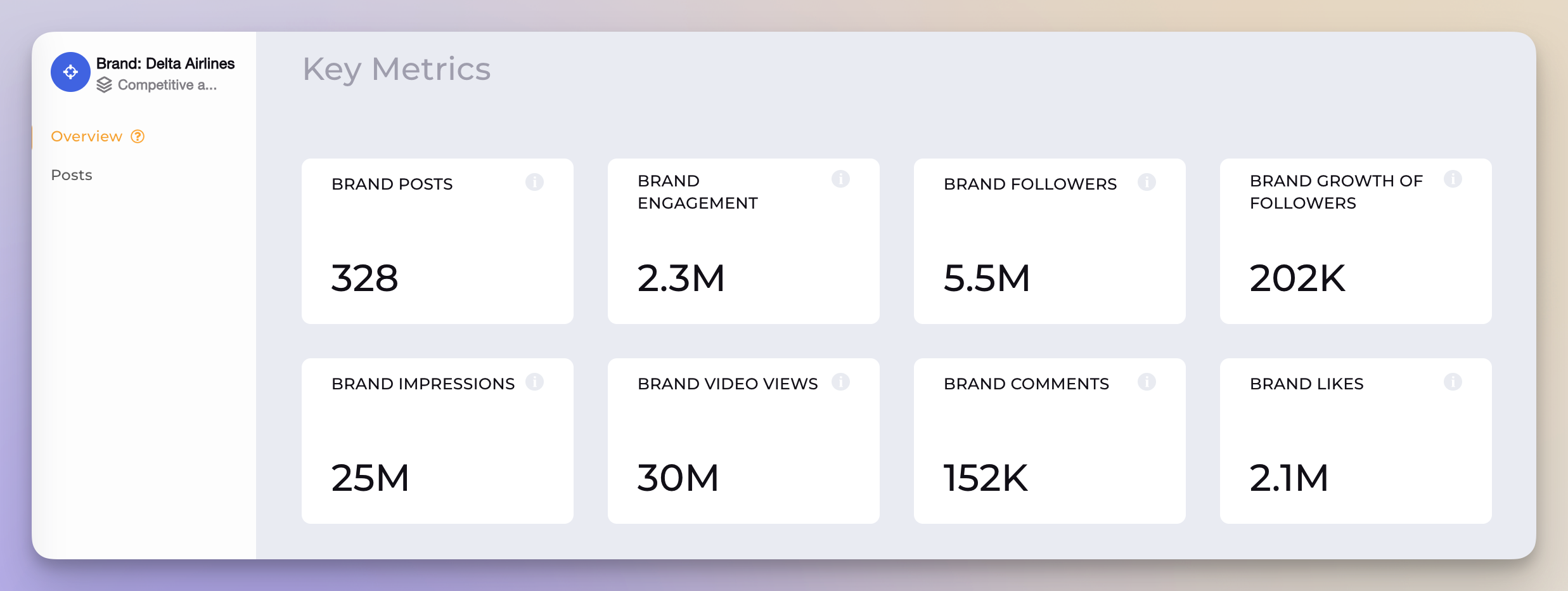
Get powerful social media performance data!
Run a social media SWOT analysis with Socialinsider and discover optimization insights!
Start your 14-days FREE trial!How does a SWOT analysis help you get better at social media marketing?
As opposed to making decisions based on hunches or copying what others are doing, a social media marketing SWOT analysis gives you insights into where you stand and where you should go next.
Here are the main benefits for social media managers:
Get context for more accurate goal setting
- Identify realistic benchmarks based on your current position
- See which platforms deserve more attention
- Understand what success looks like for your specific situation
Stay in tune with trends
- Spot emerging opportunities on platforms like TikTok, LinkedIn, or Instagram
- Notice content formats gaining traction with your audience
- Understand which social media marketing trends match your capabilities
Stay competitive
- Identify gaps between your social media work and competitors
- See what others are doing well that you could adapt
- Pinpoint unique strengths you can emphasize to stand out
Optimize social media budget allocation
- Get data on which platforms deliver the best returns
- Identify underperforming areas where spending can be reduced
- Spot opportunities worth additional investment
A thorough social media SWOT analysis example might help a small business discover that their tutorial videos receive consistent shares on Facebook (strength), their Instagram photos aren’t generating engagement (weakness), their video content performance suggests an opportunity to expand into TikTok, and algorithm changes pose a significant threat to their organic reach.
With these insights, they can make data-driven decisions rather than simply following industry trends that might not work for their specific situation.
How to do a social media SWOT analysis?
Want to do a social media SWOT analysis but don’t know where to start? It’s all about getting organized with your social data. Tools like Socialinsider make it easy to grab those numbers and see what’s really happening. Let’s walk through it.
Step #1 Strengths assessment
Start by examining your content performance across all social channels. When conducting a SWOT analysis for social media, focus on these key marketing metrics:
- Reach and impressions. Look at how many people your content reaches and how many impressions it generates. This data helps you identify which platforms give you the most visibility. In the example below, you can see Ryanair’s impressions across channels. Twitter has the highest number of impressions, though the number is decreasing. Meanwhile, Facebook shows growth, which shows that the platform is gaining momentum.
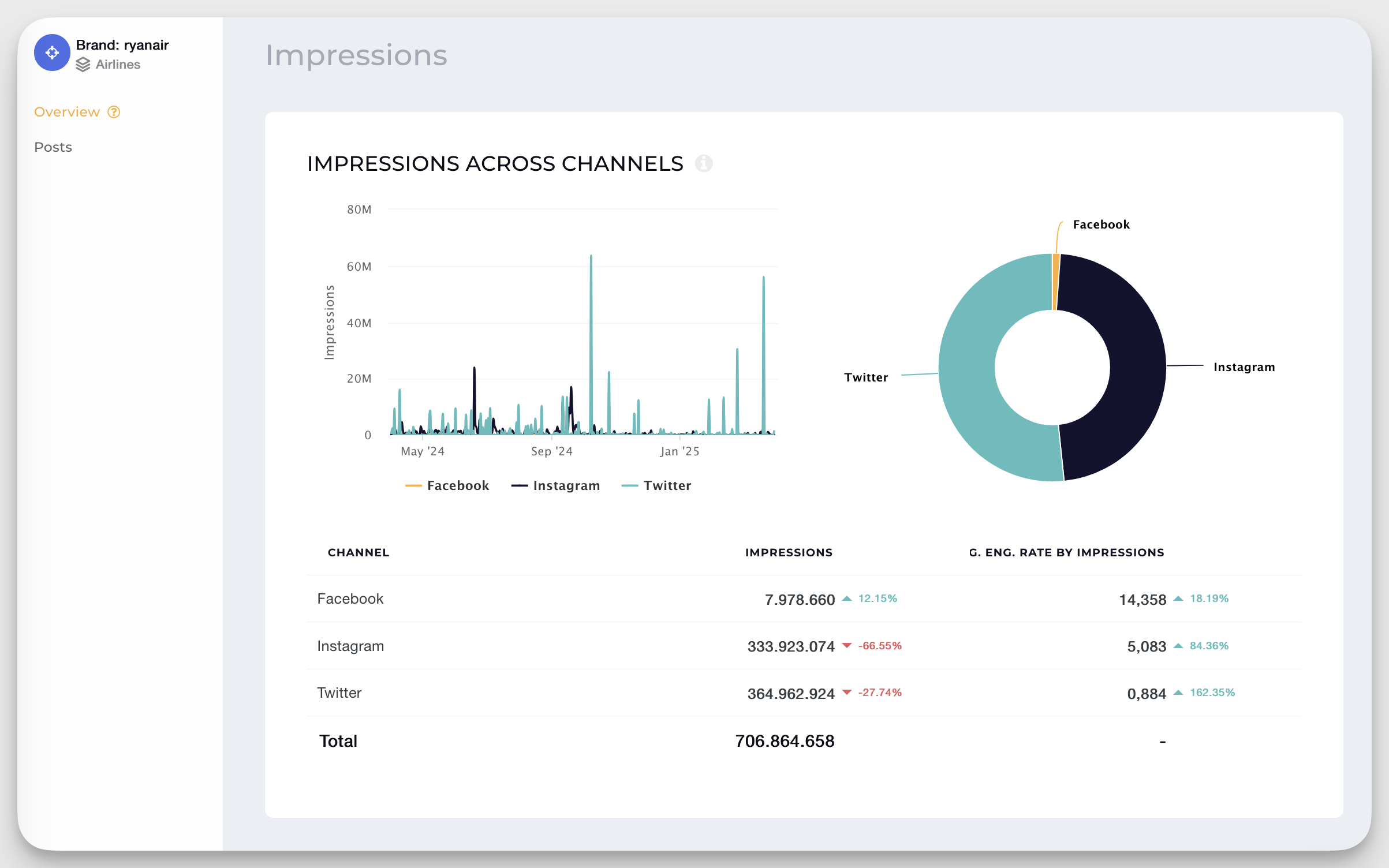
- Video views. Analyze how your video content performs across platforms. Continuing the Ryanair example, the data shows TikTok dominates with the most video views (and increasing), while YouTube views are decreasing. Facebook and Instagram show no video views, indicating a potential area for improvement or reallocation of resources.
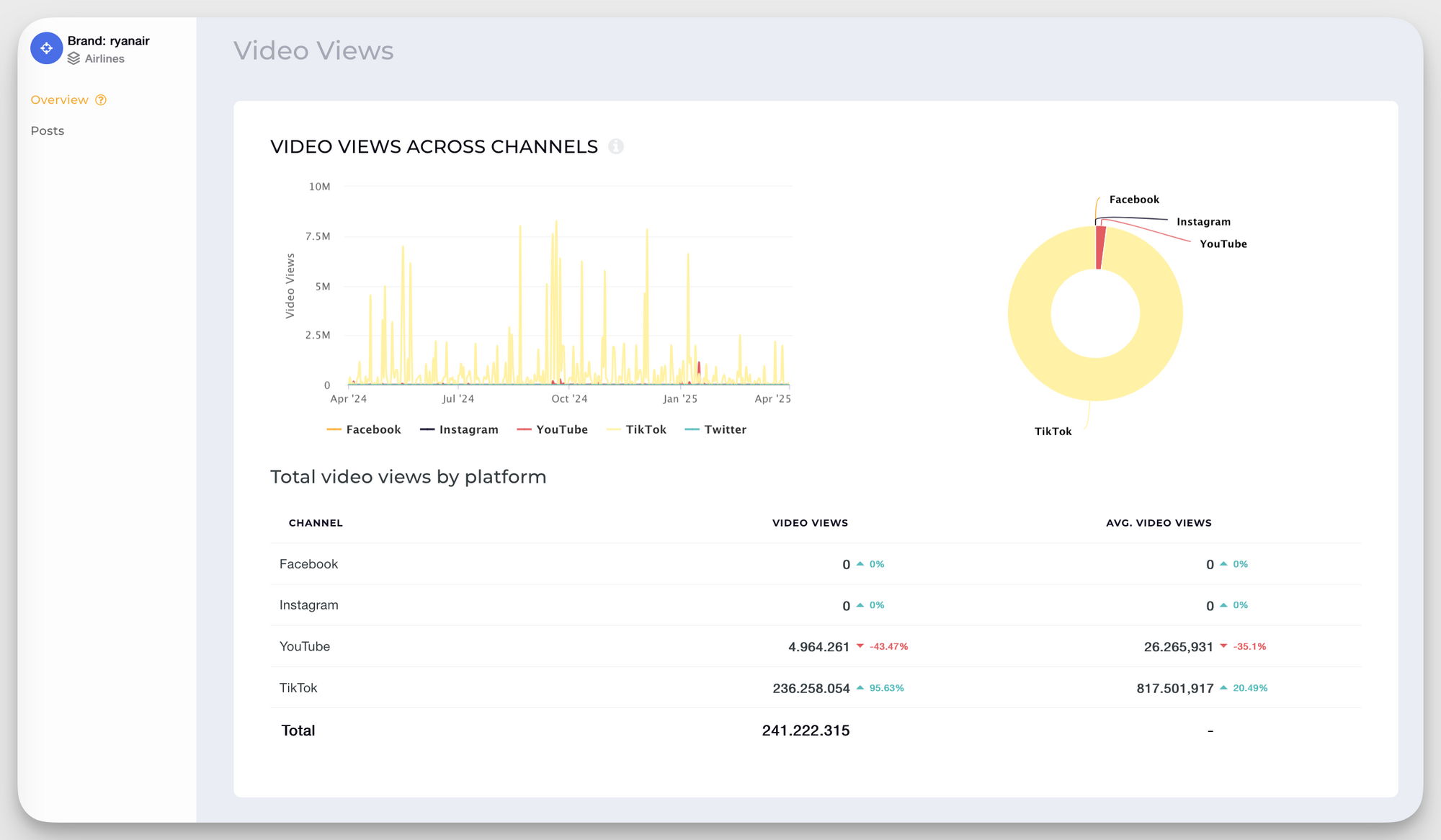
- Engagement. Consider overall engagement rates to understand where your audience is most active. Looking at the social media analytics dashboard, we see that TikTok leads in terms of engagement (and growing), followed by Instagram (which is decreasing). This indicates where your content resonates most with audiences.
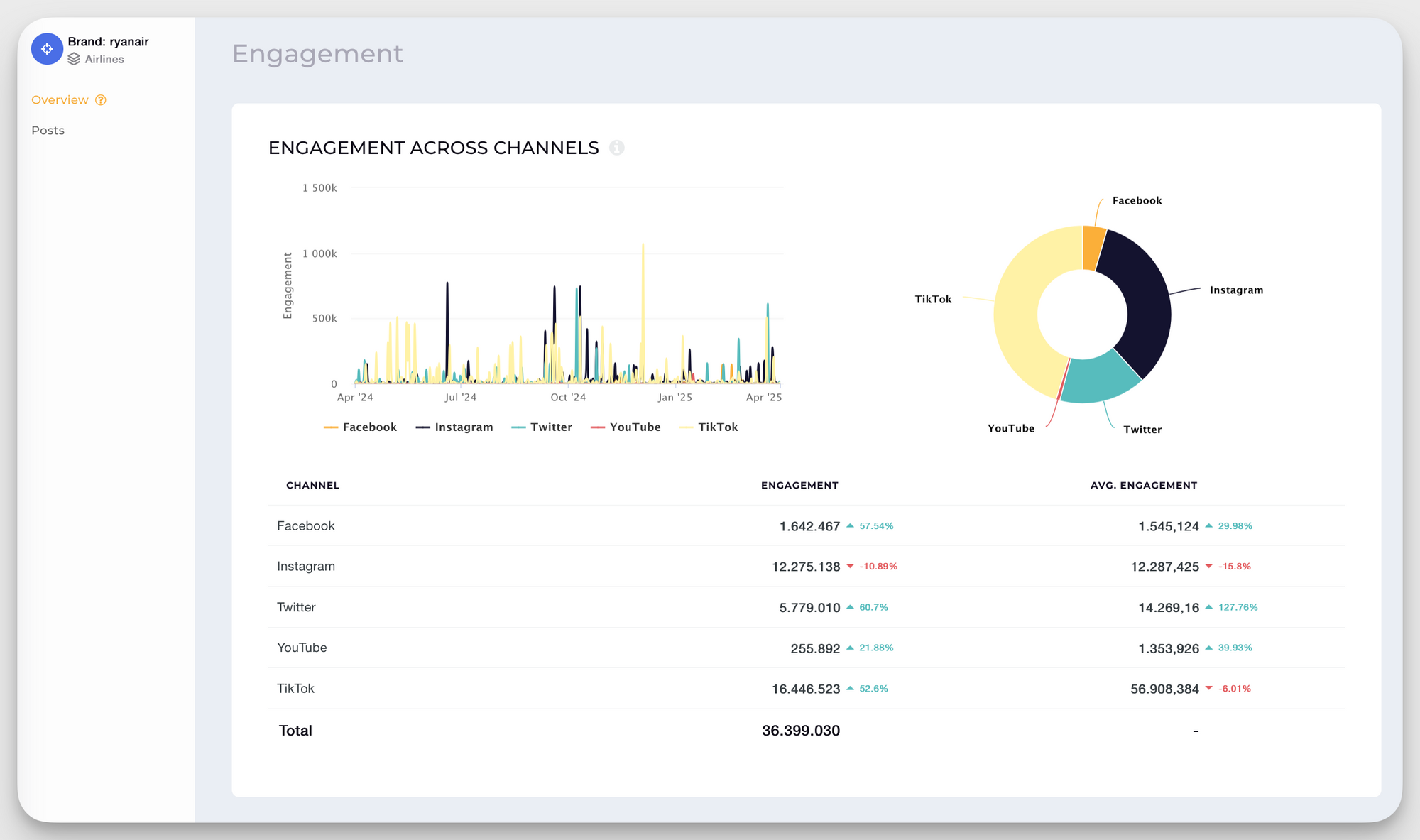
- Top-performing content pillars analysis. Use social media analysis to identify which content themes or topics perform best. For Ryanair, safety & security updates generate the highest engagement rate and perform best on Twitter (X). Customer stories & testimonials and behind-the-scenes content also perform well. This shows which content themes connect with your audience.
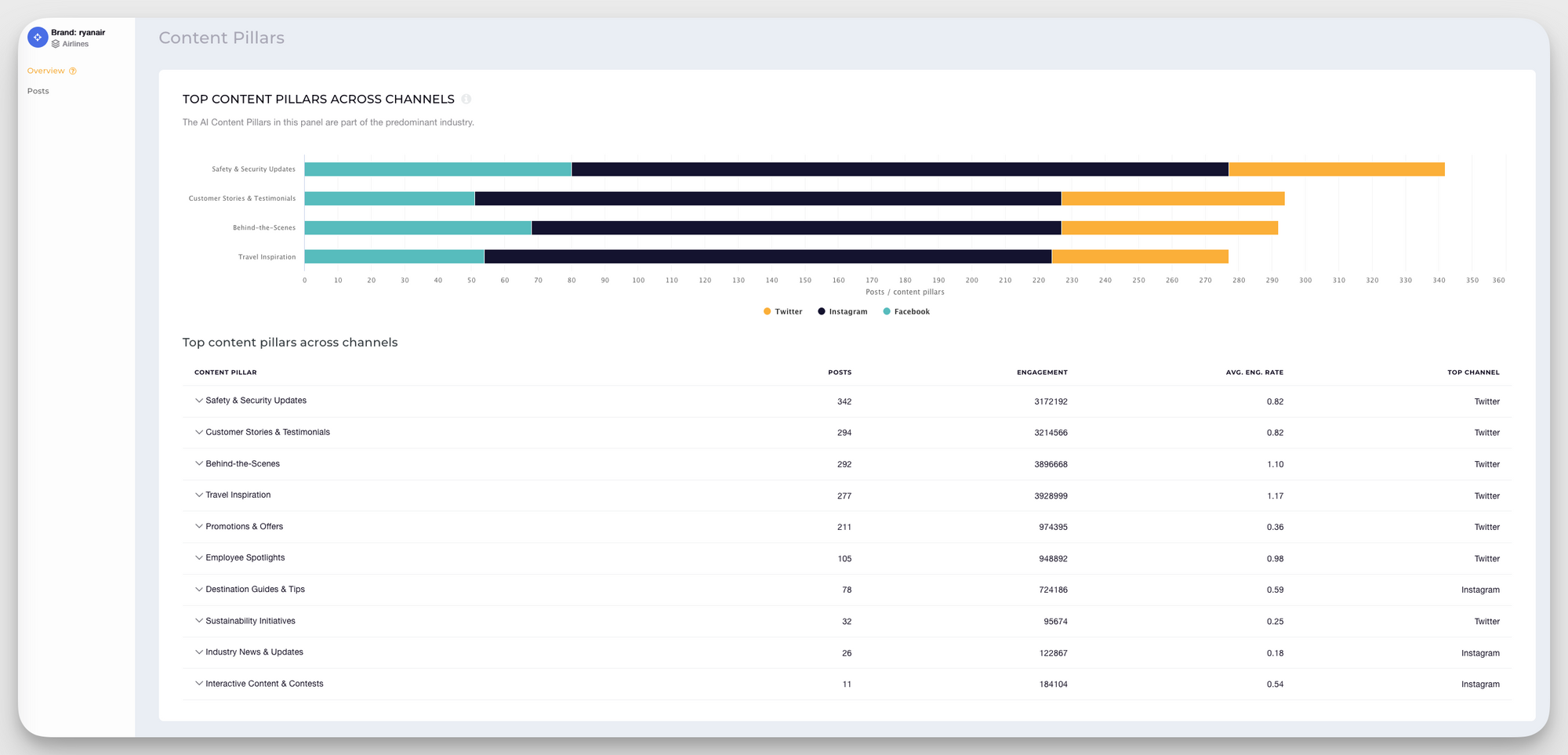
- Best posts analysis. Examine your most successful individual posts to understand what works. In our example, promotions & offers and safety & security updates dominate the top-performing posts. Note which elements these posts have in common — they might include humor, timely updates, or great visuals.
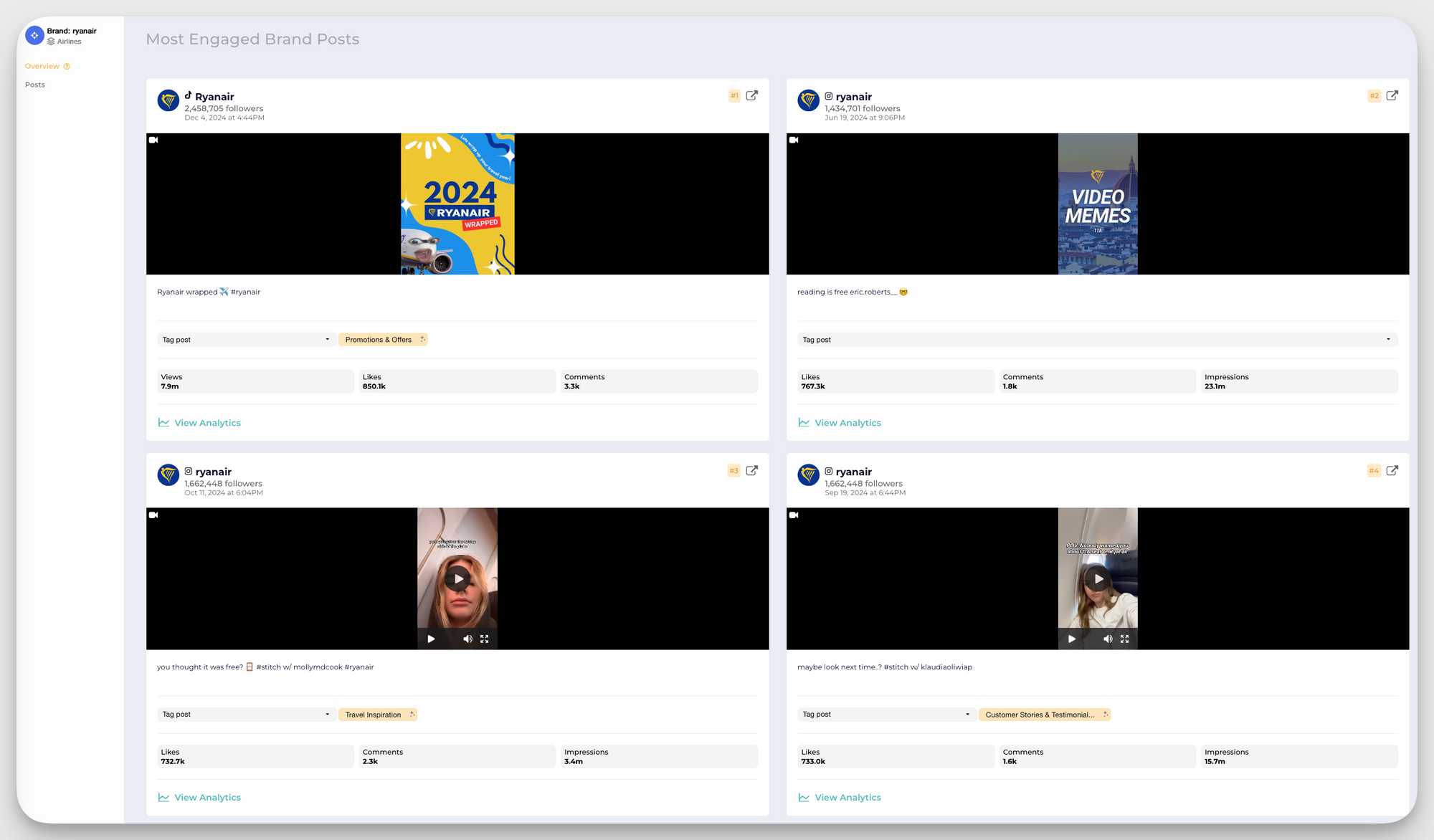
- Best performing content formats across platforms. Determine which content types drive the most engagement. We see below that reel posts generate the highest engagement, followed by carousels. This shows that video posts perform best for this brand.
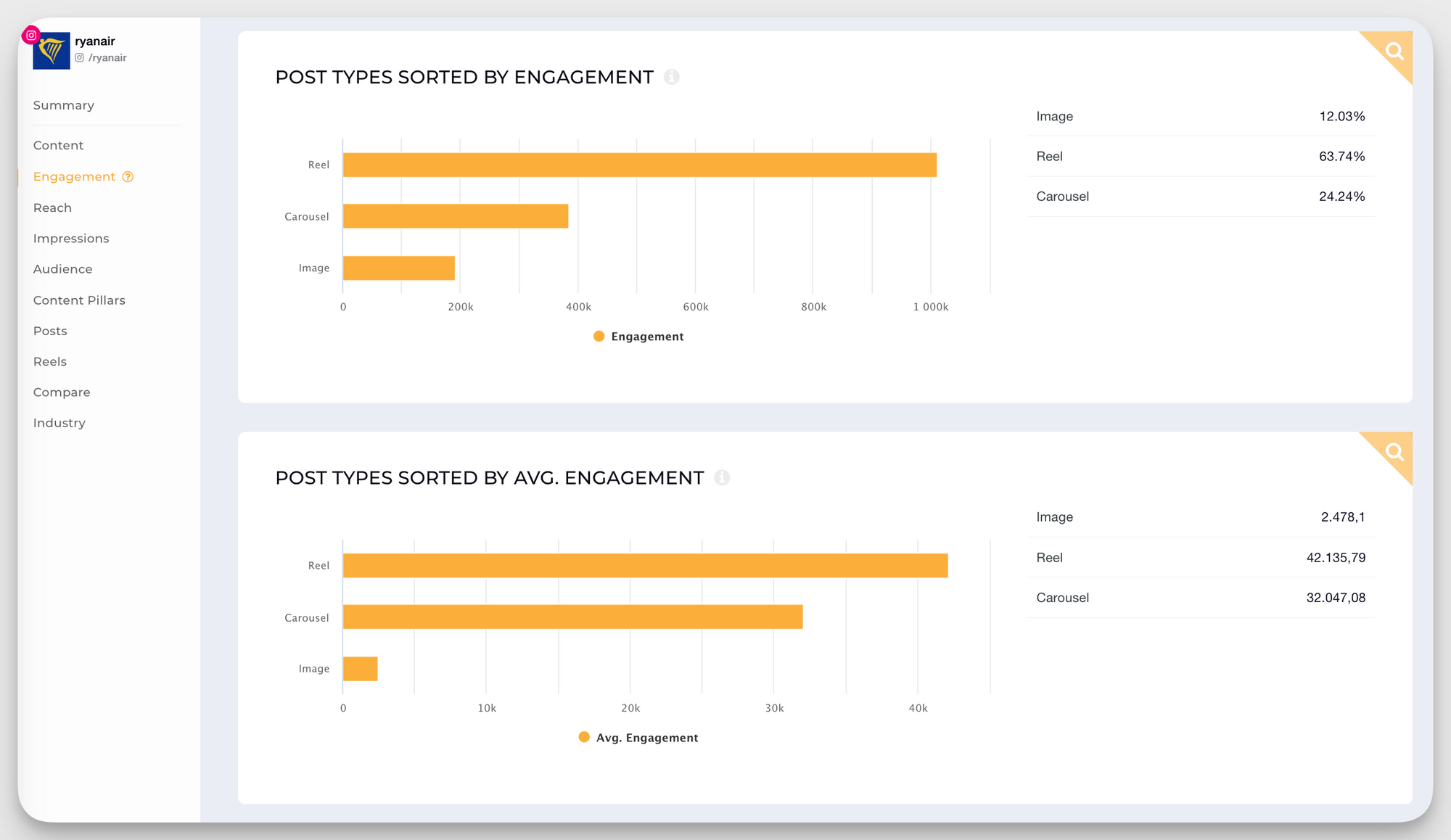
Based on the data above, identify your social media competitive advantages:
- Which platforms do you excel on?
- What social media content types or themes perform exceptionally well?
- Where do you have unusually high engagement rates compared to industry standards?
These areas represent your strengths in a social media marketing SWOT analysis and should be the ones you continue to invest in.
Step #2 Weaknesses evaluation
After identifying your strengths, it’s important to assess honestly where your social media strategy falls short. When conducting a SWOT analysis for social media marketing, you can turn those weaknesses into strengths.
To recognize underperforming content and platforms, start by looking at the data to identify which content types, themes, or platforms aren’t delivering results. Look for:
- Low engagement rates compared to your other content
- Declining reach or impressions
- Poor conversion rates from social traffic
- Platforms where growth has stalled or reversed
Also, review your current strategy against your business goals to find misalignments:
- Are you active on platforms where your target audience spends time?
- Do you have consistent posting schedules across all platforms?
- Are you allocating resources proportionally to platform performance?
- Is your content mix varied enough to engage different audience segments?
Comparing your social media performance to competitors can help you reveal gaps you might have missed. For example, in this comparison we performed using Socialinsider, we see that Ryanair is more active on social media compared to WizzAir, and their increased posting frequency has also led to greater engagement.

Also, when comparing their most engaging social media content pillars, we can see that Ryanair generates higher engagement with its safety & security content pillar than Wizz with its BTS content pillar, which indicates that Ryanair’s content approach is more effective.

Look for patterns in what competitors do well that your brand doesn’t:
- Content types you haven’t explored
- Platforms where you have minimal presence
- Engagement tactics you haven’t implemented
- Audience segments you aren’t targeting
Some social media weaknesses might mean you have to let go of a platform or format that isn’t performing, while others might require additional investments in testing and improving content types and channels.
Step #3 Opportunities analysis
The opportunities section of your social media SWOT analysis focuses on factors that could benefit your strategy. This is where you identify potential growth areas and new directions for your social media marketing.
Identify trends that align with your brand and audience:
- New platform features, such as YouTube’s AI dubbing, X’s long-form articles, or LinkedIn’s thought leader ads that open new ways to reach our target audience.
- Content format innovations, such as interactive live-stream shopping on TikTok or AI-generated podcasts, present opportunities to adapt and expand your content strategy.
- AI and automation tools, such as ChatGPT for copywriting, Canva’s AI design tools, and Meta’s Advantage+ ad targeting, help brands create, schedule, and optimize content efficiently.
- AR/VR experiences for creating augmented reality filters or virtual shopping experiences, like Sephora’s Virtual Try-On and IKEA Place, enhance the shopping experience.
When conducting a cross-channel strategy SWOT analysis, look for trends that span multiple platforms to maximize your investment.
Look beyond your current audience for growth potential:
- Demographic gaps — Are there age groups, locations, or interest groups that your content isn’t reaching but should be?
- Platform-specific audiences — Analyze where your target audience spends time, but where you haven’t established a strong presence.
- Community building — Could you create groups, communities, or recurring events to create deeper connections?
- User-generated content — Are there opportunities to encourage followers to create content about your brand?
For a TikTok marketing SWOT analysis specifically, you might discover opportunities in trending hashtags, video challenges, or creator collaborations that align with your brand values.
For Instagram, opportunities might include expanding into under-utilized formats like Reels or creating themed content series that encourage regular return visits.
Across platforms, collaborations have a lot of growth potential. Explore strategic partnerships that can expand your social media reach and add credibility:
- Influencer collaborations — Find creators your ideal customers already love and team up for real connections.
- Brand partnerships — Find brands that fit with yours (but aren’t direct competitors) for awesome joint campaigns.
- Industry experts — Experts can really level up your content and make your channels way more trustworthy.
- Customer advocates — With the right incentives, your loyal customers could become your best brand ambassadors.
When exploring opportunities in social media marketing, prioritize those that align with your overall business goals and the strengths you identified earlier in your analysis.
Step #4 Threat assessment
To wrap up your SWOT analysis, you need to look at potential problems. This way, you can plan ahead and keep your social media on track.
Competitive landscape mapping is a must. A thorough SWOT analysis in marketing requires an honest assessment of how competitor movements might threaten your position.
Here’s what to look at:
- Increased social media competitor activity — When competitors increase their posting frequency or advertising spend, your content may receive less attention.
- New market entrants — New brands with fresh approaches can quickly capture audience interest and market share.
- Competitor content innovations — If your competitors try new, cool content that clicks with your audience, you might lose some engagement.
- Share of voice changes — Track whether your brand’s share of the conversation in your industry is growing or shrinking compared to competitors.
Like it or not, platform algorithm changes frequently pose threats. Keep an eye out for:
- Organic reach limitations — Platforms frequently reduce organic reach to encourage paid promotion (it’s a bummer, but it’s been going on since the early days of Facebook).
- Content prioritization shifts — Changes in what content types algorithms favor (e.g., from image to video) can suddenly reduce your content’s visibility.
- New metrics emphasis — When platforms change which engagement metrics they value most, your content strategy may need rapid adjustment. For example, Instagram’s shift from likes to saves/shares forced brands to change their content strategy.
- Feature removal — Platforms sometimes let go of features you invested in. For example, when Twitter (X) killed Fleets in 2021, brands that had put resources into creating content for the disappearing stories had to redirect their strategy back to standard tweets or other content types.
Also, watch out for changing privacy and content regulations.
- Data collection restrictions — Targeting gets limited because of privacy rules, so your reach could drop.
- Content moderation policies — Changing rules about acceptable content can affect your posting strategy or even risk account restrictions.
- Cross-border compliance — Different regions have varying regulations about promotions, disclosures, and data usage that complicate global strategies.
Knowing how all these factors can hurt your online presence helps social media strategists create concrete plans to deal with them. And speaking of plans…
Tips when conducting a social media SWOT analysis
Okay, you’ve got your social media SWOT done. Now what? Time to turn those findings into real results. Here are social media best practices to make the best out of your SWOT analysis.
Create actionable insights from your SWOT analysis
The power of a social media SWOT analysis comes from connecting the four quadrants to create practical next steps:
Connect strengths to opportunities
A social media strategy SWOT analysis works best when you build bridges between what you already do well and where you could grow. Use your existing advantages to capture new possibilities:
- If your strength is high engagement on video content, and you’ve identified TikTok as an opportunity, prioritize expanding to that platform with your proven video content approach.
- When your content creation team excels at a particular style, look for trending topics or formats where that style would stand out.
- If your community management is strong, consider opportunities to create more interactive content that sparks conversation.
Use strengths to mitigate threats
Your existing advantages can help defend against potential social media challenges:
- If algorithms hurt your reach, but you’ve got a great community, make content people want to share.
- When competitors get active, focus on your unique brand — they can’t copy that.
- If targeting gets limited by privacy rules, rely on making content everyone loves to keep things going.
Address weaknesses through opportunities
Strategic growth can help overcome current limitations:
- If you’re bad at posting regularly (hey, it happens to the best of us), use scheduling tools to keep your content consistent.
- If your visuals aren’t great, team up with creators who excel at creating great images and videos.
- If your team’s clueless about TikTok, get them trained or hire someone who knows it.
Develop SMART goals based on SWOT findings
A SWOT analysis isn’t just a nice quadrant you can put on a fancy slide. Use your SWOT insights to set up SMART goals that’ll give you real, measurable progress:
- Specific: Instead of “improve our Instagram presence,” create goals like “increase Instagram Story engagement by focusing on our top-performing behind-the-scenes content.”
- Measurable: Attach numbers to your goals — “Increase video content engagement by 15% by implementing the carousel format that performs well for competitors.”
- Achievable: Set realistic targets based on your resources and past performance data from your SWOT analysis.
- Relevant: Ensure goals connect directly to business objectives — growing followers only matters if it supports broader marketing aims.
- Time-bound: Add deadlines to create urgency, like “implement three new content formats identified in our opportunities analysis within the next quarter.”
SWOT + SMART = strategic focus. When you create social media marketing goals based on your findings, you direct efforts towards the most impactful changes rather than making changes based on hunches or irrelevant trends.
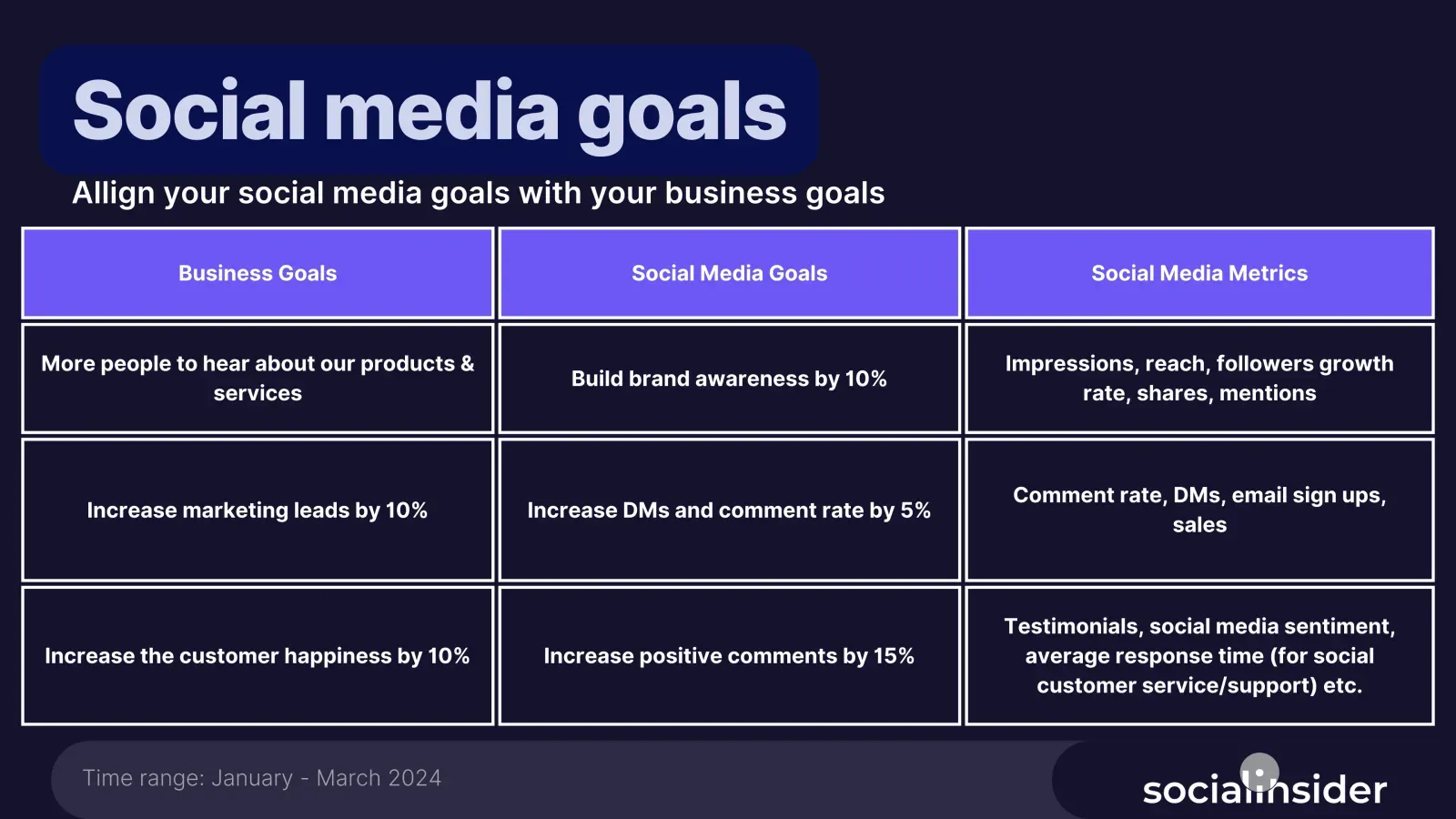
Helpful tools for doing a social media SWOT analysis
Want to make your SWOT analysis easier? Here are social media marketing tools to help you grab the data and insights you need.
Socialinsider — for social media analytics
You’ve already seen earlier in the article how helpful an analytics tool like Socialinsider can be in generating practical social media insights.
The platform provides in-depth analytics across multiple platforms, making it ideal for conducting a thorough social media SWOT analysis.
The tool offers:
- Cross-platform social media metrics to identify strengths and weaknesses
- Competitor benchmarking to spot opportunities and threats
- Content pillar analysis to understand what resonates with your audience
- Historical data to track performance trends over time
Socialinsider offers visual reports that make it easy to identify patterns in your social media marketing performance and fill in the gaps in your social media SWOT analysis.
Digimind — for brand reputation management
Monitoring brand sentiment and industry conversations helps identify external opportunities and threats. Digimind offers:
- Social monitoring capabilities to track brand mentions and sentiment
- Industry monitoring to spot trends and competitor movements
- Consumer insights to identify shifting audience preferences
- Crisis detection to help mitigate potential reputation threats
These insights are particularly valuable for the opportunities and threats sections of your social media marketing SWOT analysis.
FREE tool: Socialinsider Strategy Assistant (custom ChatGPT)
If you’re looking for an accessible entry point to social media SWOT analysis, Socialinsider offers a free Strategy Assistant powered by ChatGPT:
- AI-powered social media tool that guides you through common challenges
- Answers specific questions like “What is a good engagement rate on Instagram?”
- Helps with practical decisions such as “Should I include Reels in my strategy?”
- Simple interface with both typed questions and suggested prompts
- Provides expert insights without requiring deep analytical expertise
This specialized social media AI tool focuses on improving your social media strategy by offering practical advice for each component of your SWOT analysis.
Pretty swell, right? Try it now.
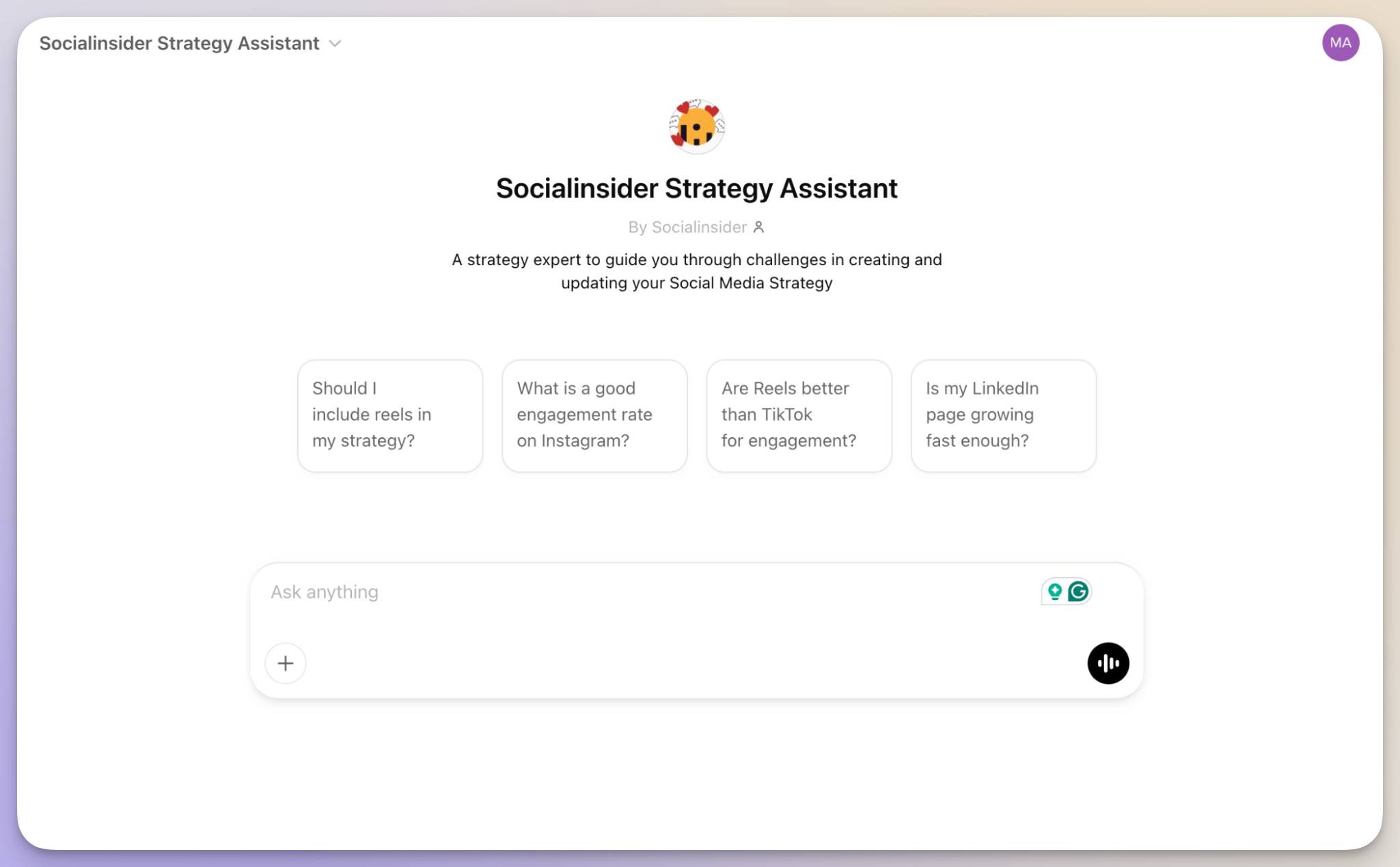
With these social media tools and this article’s tips, you’ll have a strong SWOT analysis that leads to tangible results.
When should you perform a social media SWOT analysis?
To get the most out of your social media SWOT analysis, timing matters. Here are the best moments to do it.
Launching a new campaign
Campaigns can be resource-draining. Before investing in a significant social media campaign, make sure to:
- Conduct a social media SWOT analysis to prioritize the right platforms and content types.
- Assess potential threats to figure out what could delay things.
- Identify strong points that you can use in your campaign messaging.
- Check for any potential problems and sort them out before we go live.
Doing a SWOT before your campaign means you’ll use what works and skip the old mistakes, so you’re more likely to hit your goals.
Considering investing in a new channel
A social media SWOT analysis can give you important information before deciding to invest in a new social platform:
- Evaluate whether your content strengths can translate to the new channel.
- See what’s not working well right now and if that could be worse on the new platform.
- Assess opportunities specific to the platform’s unique features and audience.
- Consider threats from established competitors already active on the platform or from any specific platform rules and regulations.
Basically, a TikTok SWOT and a LinkedIn SWOT would be completely different because each platform has its own rules. For example, your casual, entertaining behind-the-scenes content might be a strength on TikTok but a weakness on LinkedIn, where professional thought leadership performs better.
Running a social media performance audit
During regular social media performance reviews:
- Use SWOT analysis to assess strengths, weaknesses, opportunities, and threats beyond surface-level metrics.
- Track performance shifts: rising engagement may signal a new strength, while declining reach could indicate a weakness.
- Identify new opportunities — for example, a spike in video views might suggest investing more in video content.
- Detect threats early, such as algorithm changes reducing your visibility or a competitor gaining traction in your space.
Adding SWOT to your regular social media audits helps you make better decisions based on your results.
Doing competitive benchmarking
SWOT is key for competitive analysis, because it gives you a clear, organized view of where you stand. When judging your position against competitors:
- Identify comparative strengths that give you competitive advantages.
- Recognize weaknesses where competitors outperform your brand.
- Spot opportunities in gaps that neither you nor your competitors are addressing.
- Assess threats from competitor innovations or market shifts.
A social media marketing situation analysis that includes competitor benchmarking provides context for your performance and helps identify which metrics matter most in your specific market.
Using SWOT at these times ensures you’re always growing and prepared for any shifts in your business or the wider world.
Final thoughts
Think of your SWOT as a living document, not a one-off exercise. Use it strategically to position your brand, launch new products or services, test new channels, and ensure that you keep a competitive edge.
Since social media keeps changing, tools like Socialinsider give you the real-time data you need for smart planning. Start a 14-day trial and take the free Strategy Assistant for a spin to turn your SWOT analysis from just a list of ideas into tactics you can use.
Analyze your competitors in seconds
Track & analyze your competitors and get top social media metrics and more!
You might also like
Improve your social media strategy with Socialinsider!
Use in-depth data to measure your social accounts’ performance, analyze competitors, and gain insights to improve your strategy.



